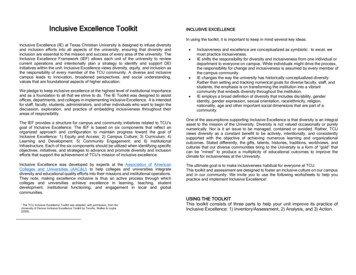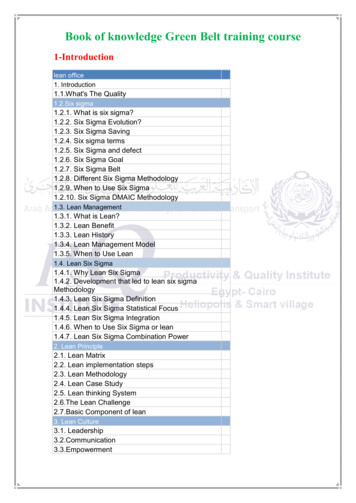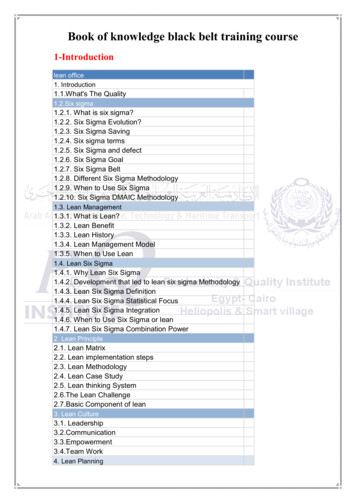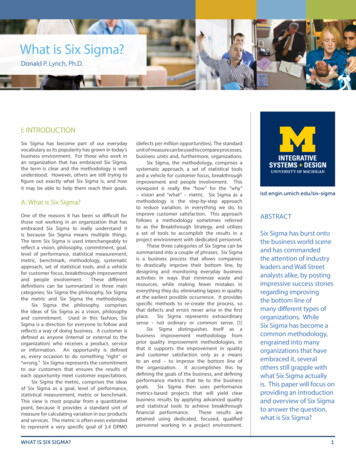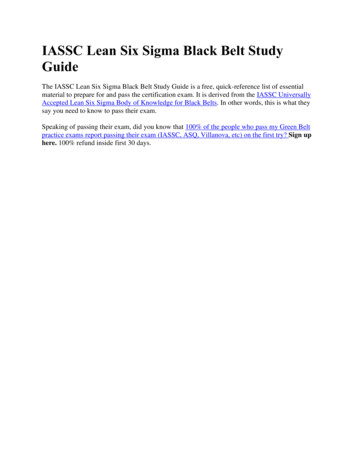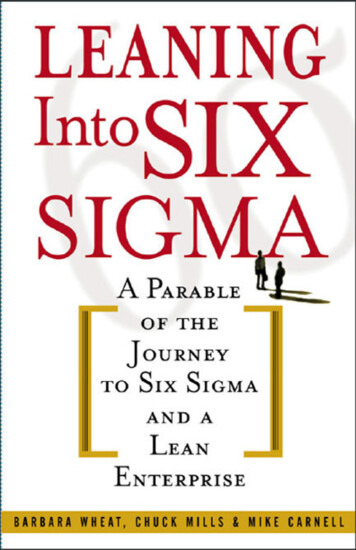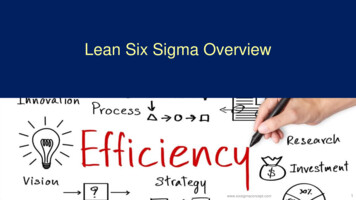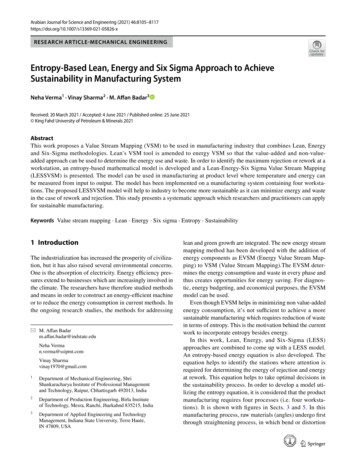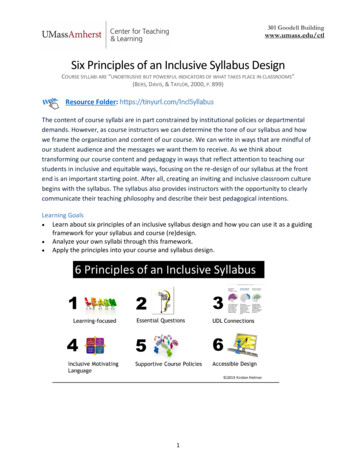
Transcription
301 Goodell Buildingwww.umass.edu/ctlSix Principles of an Inclusive Syllabus DesignCOURSE SYLLABI ARE “UNOBTRUSIVE BUT POWERFUL INDICATORS OF WHAT TAKES PLACE IN CLASSROOMS”(BERS, DAVIS, & TAYLOR, 2000, P. 899)Resource Folder: https://tinyurl.com/InclSyllabusThe content of course syllabi are in part constrained by institutional policies or departmentaldemands. However, as course instructors we can determine the tone of our syllabus and howwe frame the organization and content of our course. We can write in ways that are mindful ofour student audience and the messages we want them to receive. As we think abouttransforming our course content and pedagogy in ways that reflect attention to teaching ourstudents in inclusive and equitable ways, focusing on the re-design of our syllabus at the frontend is an important starting point. After all, creating an inviting and inclusive classroom culturebegins with the syllabus. The syllabus also provides instructors with the opportunity to clearlycommunicate their teaching philosophy and describe their best pedagogical intentions.Learning Goals Learn about six principles of an inclusive syllabus design and how you can use it as a guidingframework for your syllabus and course (re)design. Analyze your own syllabi through this framework. Apply the principles into your course and syllabus design.1
301 Goodell Buildingwww.umass.edu/ctlPrinciple 1: A Learning-Focused SyllabusTime to reflect and assess your syllabus for its orientation.Is your syllabus content- or learning-focused?1. How does your syllabus provide your students with a pathway of learning through thecourse?2. Do you provide information on what students need to do and what resources areavailable so that they can be successful learners?3. Do you state both high-level long-term goals and shorter-term measurable learningobjectives?4. Do you explain to students how content, learning activities and assessments connect?5. Are you transparent about what students need to do to successfully completeassignments?6. Are you transparent about how you will evaluate students’ learning?7. What may be confusing for your students?8. What do you need to clarify?Your Notes:2
301 Goodell Buildingwww.umass.edu/ctlPrinciple 2: Organize Your Syllabus around Big Questions & ThemesUse a backwards design process for your course design. Begin with the end inmind and identify the essential questions big ideas and themes that you want toexplore with your students. By using questions, you frame your syllabus ascontaining a “promise” through language that invites students to enter the coursewith a sense of curiosity and high expectations about how the course will be meaningful forthem.Wiggins and McTighe define essential questions as those that “push us to the heart of things –the essence” (p. 107) and that “serve as door-ways through which learners explore the keyconcepts, themes, theories, issues, and problems that reside within the content, perhaps as yetunseen” (p.106).1. What are the essential questions and big themes that you and your students will explorethroughout the course?2. For each session?3. How do these themes and questions provide a coherent narrative arc through the coursecontent?4. How do you communicate these questions and themes in your syllabus?Your Notes:IDEAS: When you write the course description make it engaging. Include some of these thoughtprovoking, intriguing questions or statements to stimulate student curiosity.Introduce the class sessions in your course schedule with the essential questions or big ideas that youwill explore instead of just providing the topic or chapter title. Here is an example:Questions/themes wewill explore thissession:Who are you? Who arewe? What’s this courseabout?How do we want tolearn together? Settingnorms for courageousconversations.How to prepare for this session: Watch: Video “Overview of the course”Do: Complete the brief online questionnaireDo: Annotate the syllabusWatch: Video The Expanding Comfort Zone ModelRead: Margaret Wheatley - Willing to be disturbedDo: Introduce yourself through the Flipgrid assignment3Live Class SessionCommunity-buildingactivitiesQ&AHopes & ConcernsactivityClass ParticipationAgreeements
301 Goodell Buildingwww.umass.edu/ctlPrinciple 3: Considering Universal Design for Learning (UDL) PrinciplesUniversal Design for Learning(UDL) is a research-basedframework for designingcurricula—that is, educationalgoals, methods, materials,and assessments—thatenable all individuals to gainknowledge, skills, andenthusiasm for learning(CAST). UDL offers a twopronged approach byreducing barriers to learningand providing rich supports.This Photo by Unknown Author is licensed under CC BY-NCHow universal is your course and syllabus design?A syllabus that reflects UDL design principles allows students to see how youintend to create a flexible learning environment. It illustrates how you design thecourse with learner variability in mind by providing students with multiple pathsfor learning and success through options and choices.1. How do you design the course with learner variability in mind by providing students withmultiple paths for learning and success?2. How do you provide options, choices and flexibility for accessing and processing coursecontent, participating in the course, and assessing skills and knowledge?3. How do you communicate this through your syllabus?Consider offering: Multimodal presentation of course content (i.e. images, graphics, videos, blogs, podcasts, orwebsites that feature real-world applications of content). Students choices about readings and topics for readings, assignments or projects Students various ways of demonstrating their learning that go beyond quizzes, exams, orwritten papers (i.e., through oral presentations, projects, performances, or products). A detailed course schedule allows students to see how course content, learning objectives,learning activities, and assignments connect. Information in the syllabus about resources and supports that will facilitate student success.4
301 Goodell Buildingwww.umass.edu/ctlPrinciple 4: Rhetoric and Tone – Inclusive & Motivating LanguageReframing our language is one way to demonstrate inclusiveness. Research has shown thatstudents perceive their instructors to be warmer, more approachable and caring when thesyllabus is characterized by friendliness, enthusiasm, and anticipation of student success. Inaddition, a positive, respectful, and inviting tone that addresses the students as competent andengaged learners fosters positive motivation. Consider using language that emphasizes acollaborative spirit and an orientation towards learning, flexibility, and possibility rather thanperformance and punishment.Cold LanguageStudents must I only accept Late work will be penalized by a deduction of40%.Students are expected to attend every classsession. Unexcused absences will result in a lowergradeWarm LanguageI encourage you to You have the opportunity to Late work is eligible for partial credit of 60%.Students are expected to comply with thefollowing course policies, or will faceconsequences.The following course values will guide ourinteractions and help you learn.It is important that you attend every classsession. Otherwise you will miss out on the manylearning activities that we will engage in.What is the rhetoric and tone of your syllabus?Syllabi function rhetorically. The language we choose and the way we framecourse content, student engagement and our course policies communicateexplicitly and implicitly our values, expectations, and how we view our studentsas learners. As students read your syllabus, what will they expect from theclassroom climate, your relationship with them, and how the semester will go?Directly address students and use of personal pronounsLearning-oriented section headingsSection in which you introduce yourself to studentsWell-articulated statement about the values andexperiences that guide your teaching practiceWarm, welcoming and inviting languageInvitations and encouragements that communicate trustand high expectations instead of commandsCooperative rhetoric, student- and learning orientedInformation on how to succeed in the courseLanguage that communicates approachability, respect,empathy, caring and commitment to student success5Current LanguageRevised language
301 Goodell Buildingwww.umass.edu/ctlPrinciple 5: Supportive Course PoliciesReframing course policies in ways that communicate support and interest in students’ successoptimizes students’ motivation and facilitates personal coping skills. Write your course policiesin ways that will help students understand the rationale behind expectations, norms andvalues. Use these statements to provide students with comprehensive information aboutresources and supports that will help them be successful learners. You can include thisinformation as electronic hyperlinks to external resources.1. How supportive and motivating are your course policies?2. How do your course policies clarify important expectations and values?3. How do the course policies empower your students as learners and facilitatepersonal coping skills?Consider this. Include an expanded “Inclusive Learning and Disability Accommodation Statement” that youbegin by stating “Your success in this class is important to me.” Where in your syllabus isthis statement? At the very end where students might miss it, or more in the center? Write a statement that motivates students to come to office hours. Offer flexible optionsfor meeting with you, use a scheduling system, and explain to your students what they gainfrom connecting with you. In writing the Academic Honesty statement through the lens of inclusiveness, assume yourstudents’ best intentions and ask yourself what they need to know to be able to complywith academic honesty. Include a statement in your syllabus in which you acknowledge your commitment toensuring that students chosen name and pronouns will be respected at all times in theclassroom. Build flexibility from the start into your policies about attendance and deadlines forassignments (as much as possible). Explain the rationale for your policies.TIP: Check out the Online Inclusive Syllabus Template for sample course policies.6
301 Goodell Buildingwww.umass.edu/ctlPrinciple 6: Accessible Design“Accessibility cannot be an afterthought and it cannot be nal syllabi are often dense, text-heavy and very hard to read, especially for studentswith dyslexia, AD(H)D, learning disabilities, or non-native speakers of English. In addition, manysyllabi do not comply with accessibility requirements or they are hard to navigate. Thefollowing steps will help you visually design an accessible and easy-to-read and navigatesyllabus.1. Is your syllabus easy to read and navigate (i.e., hierarchical headings, electronichypertext, course schedule in table format)?2. Do you use images and visual representations of information?3. Is your syllabus accessible? Create an online syllabus using Google documents. Benefits: can be accessed fromanywhere, updates are immediately viewable, Google docs automatically creates adocument outline from the headings so that readers can easily navigate the document,Google docs can be used with screen readers, screen magnifiers, and a braille display. Use interactive tools such as document-internal links and electronic hyperlinks to externalweb-based resources. Benefits: cut text, easy access to academic and social support serviceson and off campus. Make sure to use meaningful labels that indicate where a link goes. Create a course schedule in table form. Benefit: concise overview of what students canexpect to learn and what they need to do for each session. Trade some text for accessible images and visual representations of content. Block togethericons to illustrate essential course information, such as your email, office hours, the classlocation, class meeting times, and course texts. Benefit: quickly conveys information andincreases understanding.Contact MeInstructor NamePronouns:Email:Meet with MeClass Location, Day, andTimeDrop-in hours:Course MaterialsTextbook InformationOther course materialsavailable on Moodle orBlackboardScheduled hours7
301 Goodell Buildingwww.umass.edu/ctlMaking your syllabus reader-friendly Assign styles (Title, Heading 1, Heading 2) to establish a hierarchical structure within thedocument. Create a table of contents on the first page of the syllabus with document-internalhyperlinks that will allow readers to easily navigate the syllabus on their electronic devices. Create document-internal hyperlinks to connect to information located later in thedocument and hyperlinks to external resources and your course learning management site(LMS). Make sure to use meaningful labels that indicate where a link goes. 12-14 sans serif font. Dark font on light background. 1.5 line spacing. Text aligned to left. Paragraphs of between 2-4 sentences. Headings differentiate sections. Text boxes block together related information. Tables show information compactly (e.g. course schedule) Arranging the text in columns provides easy chunking. (6-9 words per line) Bulleting and numbering to organize lists. Hyperlinks to information found elsewhere (e.g. Moodle, UMass offices, disciplinary styleguides, the library) Bolded or underlined for emphasis.8
301 Goodell Buildingwww.umass.edu/ctlChecklistWhat and how students will learn: The Learning-Centered Syllabus Vision/Goal Statement Detailed course schedule Research and writings from authors of diverse backgrounds and offering multipleperspectives Experiential learning: Relevant and connected to students’ life experiences and fundsof knowledge and real-world issues Variety of in-and out-of-class learning activities that allow students to learn in differentways and through various modalities Clear student learning objectives related to course content AND the required learningprocesses Assignments offer multiple options, flexibility, choice, various ways of developing anddemonstrating knowledge Scaffolding of extensive assignments with options for review, feedback, revision Fair and clear assessment criteria: Rubrics, checklists, rationales for grading Learning objectives and assignments/assessments are well alignedWhat will help students to learn: Inclusive and Supportive Course Policies Disability Accommodation and Inclusive Learning Statement with hyperlinks to campusand other resources Inviting Office Hours Statement Expansive Academic Honesty Statement with hyperlinks to campus and other resources Pronoun Policy Course Value & Norms StatementRhetoric Welcoming and inviting tone Use of personal pronouns Cooperative languageRedundancy across modes Use of icons & logos Images of key authors, textbooks Visuals to represent main concepts Word clouds Visual representation of grade distribution Digital syllabus on course website9
301 Goodell Buildingwww.umass.edu/ctlReadability & Accessibility Clear hierarchical structure of document, using headings Table of Contents with in-document hyperlinks Text: 12-14 point sans serif font; 1.5 line spacing; bold or underline to emphasize text Text distribution: digestible sections for learners with reading disabilities, non-nativeEnglish speakers, attention-deficits Text boxes Columns White space Margins Bullet points Tables Accessible color design Alternative text for images (Format picture, Properties, Alt Text) Check with accessibility checker Flexible text that can be altered by the userReadings & ResourcesArticles Bers, T. H. Davis, B. D., and Taylor, B. (2000). The use of syllabi in assessments: unobtrusiveindicators and tools for faculty development. Assessment Update 12(3), 4-7. Palmer, M. S., Wheeler, L. B., & Aneece, I. (2016). Does the Document Matter? The Evolving Roleof Syllabi in Higher Education. Change: The Magazine Of Higher Learning, 48(4), 36-46 Womack, A. (2017). Teaching Is Accommodation: Universally Designing Composition Classroomsand Syllabi. College Composition & Communication, 68(3), 494-525.Web Resources CAST-UDL On Campus - UDL Syllabus Diagram Center - Making Images Accessible Ensuring Access through Collaboration and Technology (EnACT) project - Universal Design forLearning and your Syllabus Kairos PraxisWiki - Suggested practices for syllabus accessiblity statements Tulane University - Accessible Syllabus A Guide to Assessing the Focus of Syllabi - University of Virginia How to Create a Syllabus - Advice Guide – The Chronicle of Higher Education Mike Wesch - Steps toward a big idea syllabus CAST - About Universal Design for Learning10
begins with the syllabus. The syllabus also provides instructors with the opportunity to clearly communicate their teaching philosophy and describe their best pedagogical intentions. Learning Goals Learn about six principles of an inclusive syllabus design and how you can use it as a guiding framework for your syllabus and course (re)design
